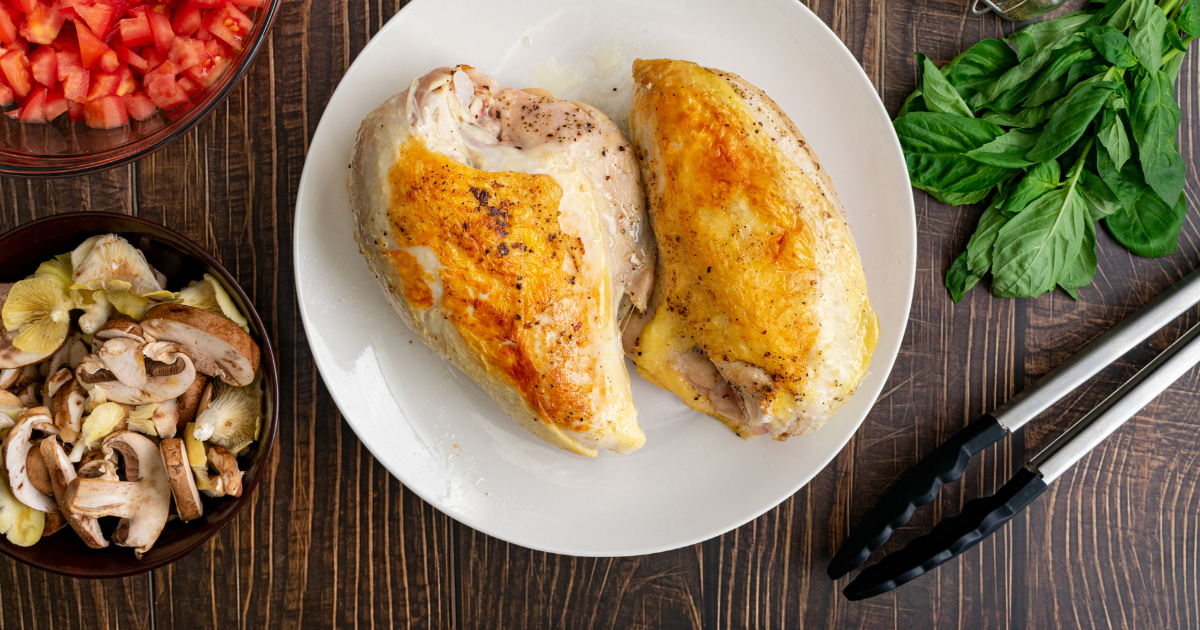Benefits of Cook Chicken of the Woods Mushrooms
Table of Contents
How to Identify and Cook Chicken of the Woods Mushrooms
Foraging for wild mushrooms is an exciting adventure. The chicken of the woods mushroom is a favorite among outdoor lovers and chefs. It has a unique texture and taste that makes any dish special.
Chicken of the woods mushrooms grow on trees and are easy to spot because of their bright colors. They are sought after for their meaty texture and great taste. Knowing how to identify and cook them is key for a safe and tasty experience.
If you love foraging or just enjoy trying new foods, this guide is for you. It covers everything about chicken of the woods mushrooms. You’ll learn how to identify them and how to cook them to perfection.
Key Takeaways
- Learn precise identification methods for chicken of the woods mushrooms
- Understand safe foraging practices in wild environments
- Discover multiple cooking techniques for wild mushrooms
- Recognize potential look-alike species to avoid risks
- Explore nutritional benefits of chicken of the woods mushrooms
Understanding Chicken of the Woods Mushroom: A Beginner’s Guide
Exploring the world of chicken of the woods mushroom is exciting. It’s a journey for nature lovers and food enthusiasts. These mushrooms are not just any fungus. They are unique and versatile, blending wild foraging with gourmet cooking.
Scientific Classification and Common Names
The chicken of the woods mushroom is known as Laetiporus sulphureus. It’s part of a group of bracket fungi. People call it by many names, including:
- Sulphur shelf mushroom
- Chicken fungus
- Sulfur polypore
Natural Habitat and Growing Seasons
Chicken of the woods mushrooms grow on hardwood trees in late summer and early fall. They like oak, cherry, and beech trees. They create bright yellow and orange clusters that are easy to spot in the forest.
These mushrooms are parasitic. They grow on living or dead trees.
Medicinal and Nutritional Benefits
These mushrooms are not just good for cooking. They are also very nutritious. They have a lot of protein, are low in calories, and might have antioxidant properties. They could also help fight inflammation.
| Nutritional Aspect | Value |
|---|---|
| Protein Content | High |
| Calories | Low |
| Potential Health Benefits | Antioxidant, Anti-inflammatory |
Whether you’re into foraging or cooking, learning about chicken of the woods mushrooms is rewarding. It opens up new worlds of culinary and natural exploration.
Essential Safety Tips for Foraging Wild Mushrooms
Foraging for chicken of the woods mushroom needs careful preparation and strict safety rules. Your journey into wild mushroom hunting requires knowledge, caution, and respect for nature’s complexity.
Before you head into the wilderness, remember these key safety tips:
- Always carry a reliable field guide specific to mushroom identification
- Learn from experienced foragers or join local mycological groups
- Never consume chicken of the woods mushroom without 100% positive identification
- Wear protective clothing and bring appropriate harvesting tools
Identifying mushrooms is crucial when searching for chicken of the woods. Getting it wrong can lead to serious health risks, including poisoning.
| Safety Aspect | Recommended Action |
|---|---|
| Identification | Consult multiple expert sources |
| Location | Understand local foraging regulations |
| Harvesting | Use clean, sharp tools |
| Consumption | Cook thoroughly to eliminate potential toxins |
Warning: Some people might have allergic reactions to wild mushrooms. Always do a small taste test and watch how your body reacts when trying chicken of the woods mushroom for the first time.
Respect private property and get the right permissions before foraging. Some places don’t allow mushroom collection, so check local rules to follow legal and ethical practices.
“Knowledge is your best protection when exploring the fascinating world of wild mushrooms.” – Mycology Expert
Key Identification Features of Chicken of the Woods
Finding a chicken of the woods mushroom is exciting for foragers and mushroom fans. These vibrant fungi are among the most striking wild mushrooms. Knowing their unique features is key for safe and successful finding.
Visual Characteristics and Colors
The chicken of the woods mushroom is known for its bright look. You’ll often see them in:
- Bright orange
- Vivid yellow
- Soft sulfur-yellow
They look like chicken meat, thanks to their texture. The mushroom grows in clusters that fan out from a center. This makes them stand out against tree bark.
Growth Patterns and Host Trees
Look for chicken of the woods mushrooms on deciduous trees. They especially like:
- Oak trees
- Beech trees
- Cherry trees
- Eucalyptus
They grow on tree trunks or fallen logs, forming large brackets. The mushroom often appears in late summer and early autumn. This is the best time to find and pick them.
Look-alike Species to Avoid
It’s important to identify chicken of the woods mushrooms correctly. Some similar fungi can be harmful. Watch for these key features to avoid mistakes:
- Bright, consistent coloration
- Smooth, uniform texture
- Absence of traditional mushroom gills
- Firm, meaty consistency
Always check with an expert or experienced forager before cooking chicken of the woods. Never eat a mushroom you’re not sure about.
Best Harvesting Practices and Techniques
Harvesting chicken of the woods mushrooms needs careful technique. It’s important to respect the mushroom and its forest home. When you’re foraging, use your knowledge and precision.
Before you start harvesting, keep these tips in mind:
- Use a sharp, clean knife to cut mushrooms at the base
- Leave a small portion of the mushroom attached to the host tree
- Inspect the mushroom for signs of decay or insect damage
- Harvest only mature chicken of the woods specimens
Your tools are key for successful foraging. Carry a breathable basket or mesh bag for your mushrooms. This helps spores spread and keeps air flowing.
When picking mushrooms, look for:
- Color vibrancy and texture
- Absence of brown or black discoloration
- Firm, meaty consistency
- No signs of insect infestation
Ethical foragers know the value of sustainable harvesting. By cutting mushrooms carefully and leaving some, you help future growth. This keeps the forest’s ecosystem balanced.
Cleaning and Storing Your Wild Mushroom Finds
After finding chicken of the woods mushrooms, it’s important to handle them right. This keeps their flavor and makes them last longer. Cleaning and storing them the right way is key to keeping them fresh and safe.
Essential Cleaning Techniques
Here’s how to clean your chicken of the woods mushroom:
- Gently brush off visible dirt and debris using a soft mushroom brush
- Avoid soaking the mushrooms directly in water, which can reduce their texture
- Use a slightly damp cloth to wipe individual mushroom surfaces
- Inspect each mushroom section for hidden insects or damaged areas
Smart Storage Solutions
Storing your mushrooms right is crucial. They need special care to stay fresh.
- Store cleaned mushrooms in a paper bag in the refrigerator
- Avoid sealed plastic containers, which trap moisture
- Consume fresh chicken of the woods recipes within 3-5 days
Preservation Techniques
Want to keep your mushrooms longer? Try these methods:
- Drying: Slice mushrooms thinly and use a food dehydrator at low temperatures
- Freezing: Sauté mushrooms briefly before freezing in airtight containers
- Create dried mushroom powder for seasoning various dishes
By cleaning and storing your mushrooms carefully, you’ll enjoy them more. You’ll also make tasty chicken of the woods recipes with ease.
Basic Preparation Methods for Chicken of the Woods
Learning to cook chicken of the woods mushrooms turns them into tasty dishes. Before starting your chicken woods recipe, it’s important to prepare them right. This unlocks their special flavor and texture.
First, clean your mushrooms well. Use a soft brush or a damp cloth to remove dirt. Don’t wash them in water, as they soak up moisture fast. Cut them into the same size pieces for even cooking.
- Slice mushrooms into 1/4 to 1/2 inch thick strips
- Remove any tough or woody sections
- Pat dry with paper towels to remove excess moisture
Marinating can make your chicken of the woods recipe even better. Mix a marinade with:
- Olive oil
- Garlic
- Fresh herbs like thyme or rosemary
- Salt and pepper
There are different ways to cook them. Sautéing is the most common method. Heat a skillet with butter or oil, then cook the mushrooms until they’re golden. Season them as you like. Grilling and roasting also work well, giving a crispy outside and a soft inside.
Make sure to cook the mushrooms well. Raw or undercooked chicken of the woods can upset your stomach. Cook them until they’re safe to eat.
Popular Chicken of the Woods Recipes
Exploring chicken of the woods recipes can change how you cook. This unique mushroom is full of flavor and fun to use in the kitchen. It’s perfect for both home cooks and mushroom lovers.
Crispy Fried Mushroom Strips
Try chicken of the woods fried for a tasty twist on usual dishes. Here’s how to make crispy mushroom strips:
- Clean and slice mushrooms into uniform strips
- Create a seasoned breading mixture with panko crumbs
- Dip strips in beaten egg
- Coat thoroughly with seasoned breading
- Deep fry until golden brown and crispy
Wild Mushroom Pasta Dishes
Adding chicken of the woods to pasta makes meals richer and more flavorful. Here are some great ways to prepare it:
- Sauté mushroom pieces with garlic and herbs
- Toss with al dente pasta
- Finish with parmesan cheese
Vegetarian Main Course Options
Chicken of the woods mushrooms are great for vegetarians. They have a meaty texture that’s perfect for main dishes.
| Dish | Preparation Time | Difficulty |
|---|---|---|
| Mushroom “Steak” Cutlets | 30 minutes | Intermediate |
| Stuffed Mushroom Roast | 45 minutes | Advanced |
| Mushroom Burger Patties | 25 minutes | Beginner |
Trying out chicken of the woods recipes opens up new culinary adventures. It’s a healthy, tasty ingredient from nature.
Common Mistakes to Avoid When Cooking Wild Mushrooms
Learning to cook chicken of the woods needs careful attention. Many home cooks make mistakes that affect flavor and safety. Knowing these common errors will help you make tasty and safe mushroom dishes.
- Overcooking risks: Mushrooms can become tough and rubbery if cooked too long. Cook them briefly to keep their tender texture and flavor.
- Improper cleaning: Quick cleaning can leave dirt or contaminants. Always check and clean wild mushrooms well before cooking.
- Seasoning mistakes: Don’t use too much seasoning. Light herbs and a few spices are best.
Choosing the right pan is important when cooking chicken of the woods. Use a wide, flat skillet for even cooking. Overcrowding makes mushrooms steam instead of brown, losing flavor and texture.
| Cooking Mistake | Consequence | Solution |
|---|---|---|
| Overcrowded Pan | Steamed, soggy mushrooms | Cook in batches, use large skillet |
| High Heat | Burnt, tough texture | Medium heat, gentle cooking |
| Skipping Preparation | Potential digestive issues | Proper cleaning, thorough cooking |
Proper technique is crucial when cooking wild mushrooms. Take your time, use gentle heat, and respect the mushrooms’ unique qualities. This way, you’ll enjoy a wonderful culinary experience.
Conclusion
Exploring chicken of the woods mushroom is an exciting journey. It needs patience, knowledge, and respect for nature. You’ll learn to identify, harvest, and prepare this unique mushroom.
When you start making chicken woods recipes, remember safety first. Each time you go foraging, you learn and connect with nature. Study the mushroom’s look, where it grows, and ask experts before picking wild mushrooms.
Keep learning to become a confident mushroom lover. Join groups, go to workshops, and always learn more. Wild mushrooms like chicken of the woods teach us to appreciate nature’s diversity.
Your journey in the kitchen is just starting. With study, practice, and a sense of adventure, you’ll make amazing dishes. These dishes will celebrate the wild ingredients we find in nature.
FAQ
Are chicken of the woods mushrooms safe to eat?
Chicken of the woods mushrooms are safe to eat if you’re sure they’re the right ones. Make sure to cook them well. Some people might have stomach issues, so start with a small amount.
How do I know if I’ve correctly identified a chicken of the woods mushroom?
Look for bright orange or yellow color, a fan-like shape, and growth on hardwood trees. They should have a smooth texture and grow in clusters. Always check with experts before eating.
What does chicken of the woods taste like?
They taste like chicken, with a mild, slightly lemony flavor. Cooked right, they’re a great meat substitute. Their taste is closest to white meat chicken.
How should I clean chicken of the woods mushrooms?
Gently brush off dirt with a soft brush or damp cloth. Don’t soak them in water. If needed, rinse lightly and dry well. Clean just before cooking for the best taste.
Can I freeze chicken of the woods mushrooms?
Yes, you can freeze them. Clean and slice first, then blanch briefly. Cool, dry, and freeze in bags or containers. They keep well for 3-6 months.
What are the best cooking methods for chicken of the woods?
You can sauté, grill, roast, or fry them. They’re great in stir-fries, tacos, or as a side dish. Make sure they’re cooked well for safety.
How can I tell if a chicken of the woods mushroom is too old to harvest?
Avoid mushrooms that are hard, discolored, or show decay. Fresh ones are soft, brightly colored, and supple. If it feels tough or dull, don’t pick it.
Are there any trees where chicken of the woods should not be harvested?
Avoid cherry, cedar, and eucalyptus trees. Mushrooms from these might cause allergic reactions. Stick to oak, beech, and other hardwoods for the best taste.


